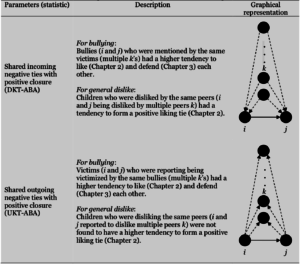The Victim of My Bully is My Friend: A Social Network Perspective on Bullying
There is no denying a major problem faced in the United States is bullying. Though the mediums through which it manifests itself has transformed with the introduction of social media in recent years, the underlying fundamentals of bullying and victim behavior has remained the same.
In a study conducted at The University of Groningen, researchers found that “Bullying ties do not occur in isolated dyads, but exist in larger networks in interplay with relations of diverse kinds. These relations in networks form complex patterns where network ties are dependent on other ties and the position of children in the network” (Huitsing). Therefore, bullying isn’t just the effects of one mean kid picking on an unlucky victim, it is an effect of a larger and more complex network and the negative ties that have been formed within it. Huitsing uses social network analysis to investigate bully-victim relationships in means to potentially find a better way to solve the problem.
Through his research, there were four main findings: (1) the interplay between negative and positive networks; (2) structural characteristics of negative tie networks; (3) child characteristics that are related to children’s involvement in victim-bully relationships; (4) agreement between informants on victim-bully relationships. For the sake of brevity, I’ll focus on the first.
The interplay between negative and positive networks “helps to understand the mechanisms that underlie bullying processes and the formation of other negative ties” (Huitsing). In the two figures below, it was found that for bullying and general dislike, two bullies (i and j) that shared common victims, had a higher tendency to like and defend each other. Similarly, two victims (i and j) who were victimized by the same bullies, were likely to like and defend each other. Victims of the same bully form positive relationships for support and affection, while the bullies of the same victim defend each other to gain power. “The results showed that positive and negative ties in networks of children are related and that ties in one network influence the realization of ties in the other. As such, knowledge about children’s positive relations (e.g., friendships, defending) contributes to our understanding of the existence and creation of bullying relations” (Huitsing).


So what could this mean moving forward? Well, according to the study, “A social network perspective with investigations into triadic structures accounts for the group processes in which bullying and other negative relations are embedded”. Understanding the underlying mechanisms for bullying may help with bullying prevention. Educating children about group dynamics can better prevent the development of these triadic closures as seen above and thus, improve social climate in schools. Furthermore, these findings can help teachers better understand the social processes behind bullying and allow them to better detect and put a stop to bullying behavior. Though this may not be the silver bullet to ending an this seemingly perpetual issue, it could help to uncover a new approach to anti-bullying programs that target the network as a whole.
[1] Huitsing, G. (2014). A social network perspective on bullying. [Groningen]: University of Groningen.